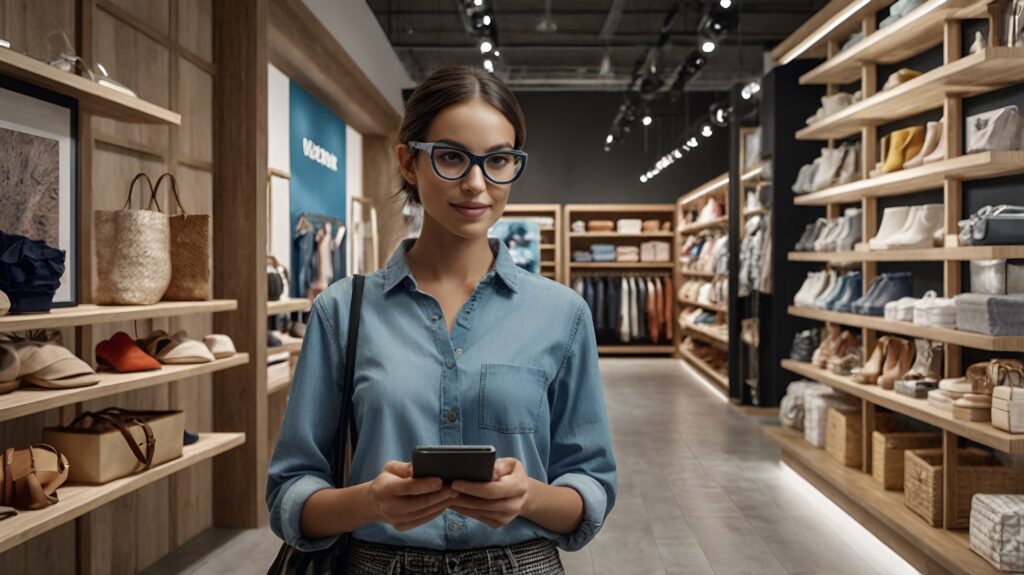Augmented Reality in Retail: A New Dimension in Shopping
As retail progressively moves to the advanced domain, brands are investigating better approaches to draw in clients and make vivid shopping encounters. Augmented reality (AR) is one of the most astonishing advancements to arise in this field. By overlaying advanced data onto this augmented reality, AR improves how purchasers experience items, whether on the web or available. From virtual attempt-ons to intelligent item shows, expanding the truth is changing the way that we shop, making it more straightforward for clients to imagine items in their lives and for brands to convey champion encounters. How about we investigate the developing job of augmented reality in retail and how it’s reshaping the shopping experience?
1. Virtual Attempt Ons: Carrying the Fitting Space to You
One of the greatest difficulties for online customers is knowing whether a thing will look or fit as they envision. AR tackles this issue with virtual take a stab at highlights that permit clients to perceive how items will look on them prior to buying. This innovation is famous in the design and magnificence businesses, where brands like Sephora, Warby Parker, and Nike offer AR apparatuses that let clients take a stab at cosmetics, glasses, and shoes utilizing their cell phones or PCs.
With AR-fueled virtual attempt ons, customers never again need to think about how a couple of shades will look all over or on the other hand in the event that a specific lipstick shade will suit their complexion. By empowering clients to pursue more educated decisions, AR upgrades the shopping experience as well as diminishes returns, which is valuable for the two clients and retailers. Virtual attempt ons are making internet shopping more private and aiding overcome any issues among advanced and actual shopping.
2. In-Store Route and Intelligent Showcases
Augmented Reality is additionally making in-store shopping really captivating and effective. AR-empowered versatile applications are so helpful. Clients can utilize their cell phones to explore stores and find items all the more without any problem. By pointing their gadget’s camera around the store, customers can get computerized prompts, headings, or data on unambiguous things. This innovation is particularly helpful in enormous retail spaces, where finding explicit items can be challenging.

Intelligent showcases are one more thrilling utilization of AR in actual stores. For instance, furniture stores like IKEA have executed AR booths where clients can see computerized pictures of furniture pieces overlaid on an actual space. This allows clients to picture how a sofa, table, or seat will thoroughly search in a room prior to making a purchase. These vivid encounters make shopping more pleasant and useful, empowering clients to investigate items in new ways.
3. Visualizing Products at Home: Augmented Reality in Home Decor and Furniture
AR is demonstrating particularly well-known in home stylistic themes and furniture retail. With AR applications like IKEA Spot and Houzz, clients can put virtual models of furniture and stylistic layout things in their own spaces to perceive how they fit and look. Utilizing a cell phone camera, customers can “place” lounge chairs, lights, and different decorations in their parlors to get a sensible view of how all that will meet up.
This sort of representation assists clients with pursuing sure choices and is especially valuable for enormous buys, where wavering is frequently higher. Customers never again need to depend exclusively on item photographs or aspects; all things being equal, they can perceive how an item will look and fit continuously, which lessens the probability of profits and increments consumer loyalty. For brands, offering AR perception devices reinforces client commitment and separates them in a profoundly serious market.
4. Enhancing Product Information
Augmented Reality additionally assists retailers with offering point-by-point, intuitive item data, which can be particularly valuable in stores where actual space is restricted. With AR, clients can point their cell phone camera at an item and immediately access data, for example, particulars, client surveys, and estimating subtleties. This component is significant for complicated or high-speculation items like gadgets, machines, and home improvement things, where customers frequently need top-to-bottom data prior to making a buy.
For instance, a client looking for another PC could utilize AR to pull up nitty-gritty specs, guarantee data, and surveys by just checking the item coming up. This involved experience assists clients with having good expectations about their buys and adds a layer of comfort, giving them momentary admittance to the subtleties they need without depending on a salesman.
5. Augmented-Reality-Enhanced Packaging: Adding Value After the Purchase
AR isn’t just valuable during the shopping system; it can likewise improve the post-buy insight. A few brands are presently including AR highlights on item bundling, permitting clients to open extra happy after they bring the item home. For instance, a wine organization could offer an AR experience where clients can filter the mark to find out about the grape plantation’s set of experiences or get wine-matching ideas.
This approach assists brands with fortifying client connections and construct dependability by giving an intelligent encounter past the underlying deal. AR-upgraded bundling likewise offers an imaginative method for instructing clients on item use or offer integral substance that enhances their experience. By adding esteem post-buy, AR empowers rehash buys and keeps clients connected long after they leave the store.
6. Gamifying the Shopping Experience
Retailers are additionally utilizing AR to make gamified shopping encounters, which draw in clients and drive commitment. With AR-based scrounger chases, for instance, brands can urge clients to investigate various pieces of a store to find “stowed away” things or procure limits. These intelligent encounters appeal to clients’ feeling of tomfoolery and experience, causing shopping to feel more like a game than an errand.
Pokémon Go, one of the primary universally famous AR games, ignited interest in the capability of AR for gamifying certifiable encounters. From that point forward, a few brands have explored different avenues regarding comparative ideas, utilizing AR to boost clients to visit stores, find new items, and take part in one of a kind exercises that make shopping more paramount. For brands, these gamified encounters assist with drawing in clients and urge them to invest more energy associating with items and advancements.
The Future of Augmented Reality in Retail
As Augmented Reality innovation propels, its applications in retail are probably going to develop much further. With AR glasses and headsets turning out to be more available, customers may before long have the option to explore stores, take a stab at items, and interface with shows completely sans hands. The proceeded with combination of AR into retail will give clients a considerably more vivid shopping experience, joining the accommodation of web based shopping with the active idea of in-store encounters.
For retailers, putting resources into AR is a strong method for meeting client assumptions and remain cutthroat in a computerized first market. AR in retail is as yet developing; however obviously, this innovation will assume a focal part in molding the fate of shopping. By mixing computerized and actual components, AR is bringing another degree of fervor, accommodation, and personalization to the retail world.








